Grow Management Consultants: Workplace Health and Safety Policy Report
VerifiedAdded on 2020/05/11
|10
|2116
|532
Report
AI Summary
This document provides a comprehensive Workplace Health and Safety (WHS) Policy and Procedures for Grow Management Consultants. The policy outlines the purpose of ensuring a safe work environment for all staff, contractors, and visitors. It defines key terms like 'hazard' and 'incident' and clarifies the responsibilities of duty holders, emphasizing the need to eliminate or minimize risks. The policy details Grow Management Consultants' commitment to legislative compliance, risk management, and continuous improvement in health and safety. It also outlines staff responsibilities, including reporting hazards and incidents. The procedures cover annual workplace inspections, hazard identification and control, incident reporting, and detailed risk assessment processes. It emphasizes the importance of identifying hazards, assessing risks, implementing control measures using the hierarchy of control, and continuous monitoring and review. The policy also includes specific guidelines for employees working from home, ensuring their work environment is safe and free from hazards. Communication and consultation with employees on health and safety matters are also highlighted.
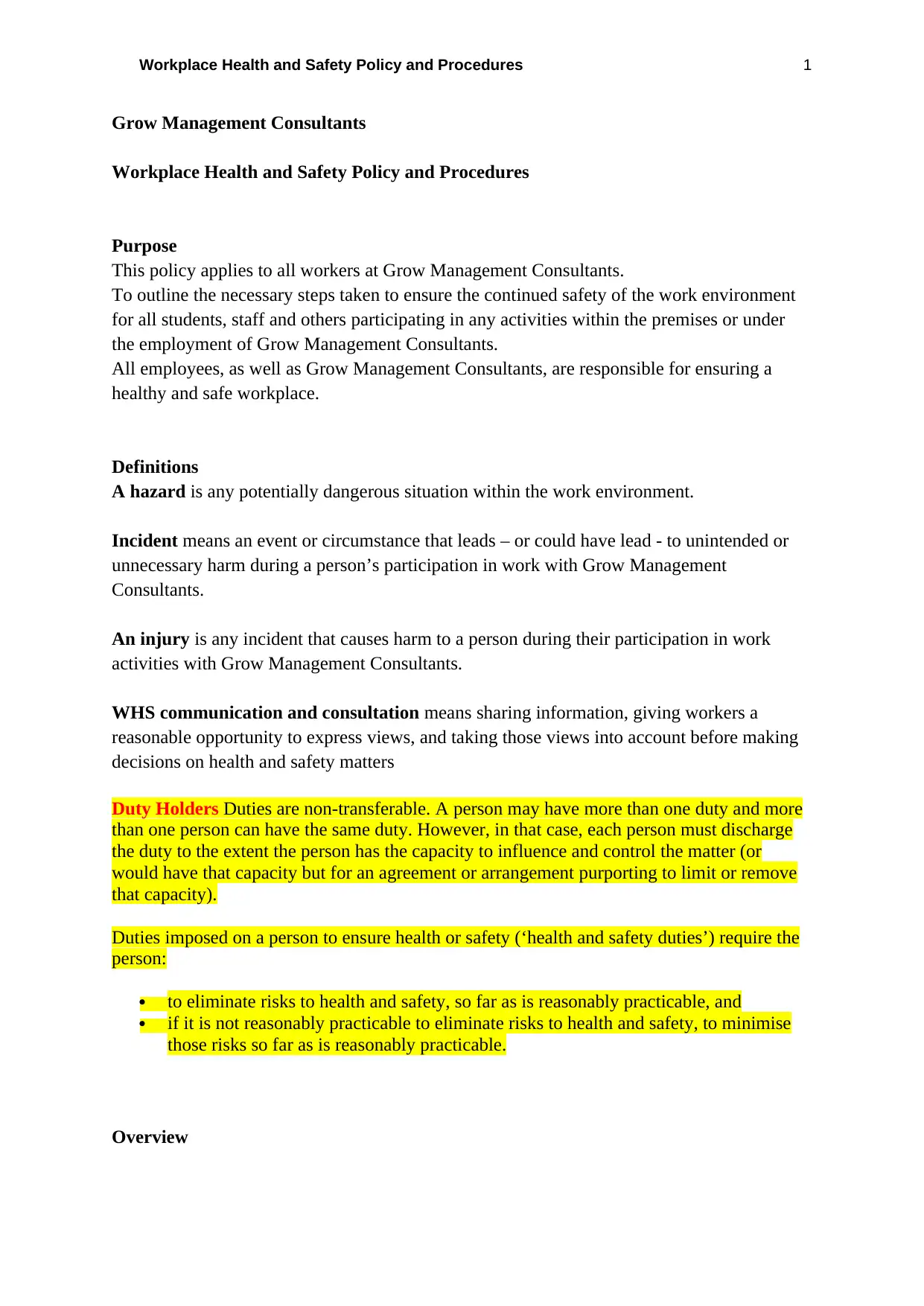
Workplace Health and Safety Policy and Procedures 1
Grow Management Consultants
Workplace Health and Safety Policy and Procedures
Purpose
This policy applies to all workers at Grow Management Consultants.
To outline the necessary steps taken to ensure the continued safety of the work environment
for all students, staff and others participating in any activities within the premises or under
the employment of Grow Management Consultants.
All employees, as well as Grow Management Consultants, are responsible for ensuring a
healthy and safe workplace.
Definitions
A hazard is any potentially dangerous situation within the work environment.
Incident means an event or circumstance that leads – or could have lead - to unintended or
unnecessary harm during a person’s participation in work with Grow Management
Consultants.
An injury is any incident that causes harm to a person during their participation in work
activities with Grow Management Consultants.
WHS communication and consultation means sharing information, giving workers a
reasonable opportunity to express views, and taking those views into account before making
decisions on health and safety matters
Duty Holders Duties are non-transferable. A person may have more than one duty and more
than one person can have the same duty. However, in that case, each person must discharge
the duty to the extent the person has the capacity to influence and control the matter (or
would have that capacity but for an agreement or arrangement purporting to limit or remove
that capacity).
Duties imposed on a person to ensure health or safety (‘health and safety duties’) require the
person:
to eliminate risks to health and safety, so far as is reasonably practicable, and
if it is not reasonably practicable to eliminate risks to health and safety, to minimise
those risks so far as is reasonably practicable.
Overview
Grow Management Consultants
Workplace Health and Safety Policy and Procedures
Purpose
This policy applies to all workers at Grow Management Consultants.
To outline the necessary steps taken to ensure the continued safety of the work environment
for all students, staff and others participating in any activities within the premises or under
the employment of Grow Management Consultants.
All employees, as well as Grow Management Consultants, are responsible for ensuring a
healthy and safe workplace.
Definitions
A hazard is any potentially dangerous situation within the work environment.
Incident means an event or circumstance that leads – or could have lead - to unintended or
unnecessary harm during a person’s participation in work with Grow Management
Consultants.
An injury is any incident that causes harm to a person during their participation in work
activities with Grow Management Consultants.
WHS communication and consultation means sharing information, giving workers a
reasonable opportunity to express views, and taking those views into account before making
decisions on health and safety matters
Duty Holders Duties are non-transferable. A person may have more than one duty and more
than one person can have the same duty. However, in that case, each person must discharge
the duty to the extent the person has the capacity to influence and control the matter (or
would have that capacity but for an agreement or arrangement purporting to limit or remove
that capacity).
Duties imposed on a person to ensure health or safety (‘health and safety duties’) require the
person:
to eliminate risks to health and safety, so far as is reasonably practicable, and
if it is not reasonably practicable to eliminate risks to health and safety, to minimise
those risks so far as is reasonably practicable.
Overview
Paraphrase This Document
Need a fresh take? Get an instant paraphrase of this document with our AI Paraphraser
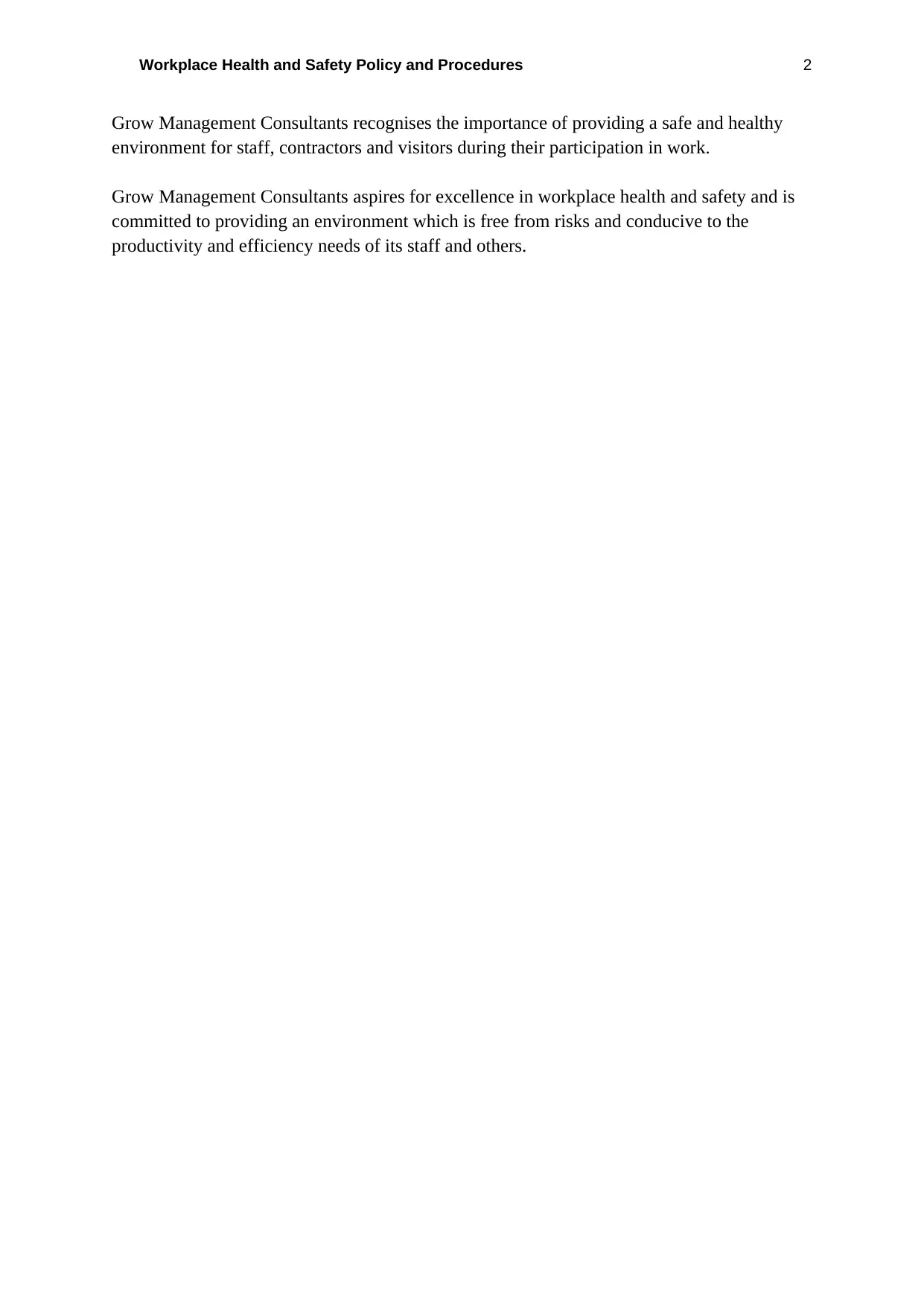
Workplace Health and Safety Policy and Procedures 2
Grow Management Consultants recognises the importance of providing a safe and healthy
environment for staff, contractors and visitors during their participation in work.
Grow Management Consultants aspires for excellence in workplace health and safety and is
committed to providing an environment which is free from risks and conducive to the
productivity and efficiency needs of its staff and others.
Grow Management Consultants recognises the importance of providing a safe and healthy
environment for staff, contractors and visitors during their participation in work.
Grow Management Consultants aspires for excellence in workplace health and safety and is
committed to providing an environment which is free from risks and conducive to the
productivity and efficiency needs of its staff and others.

Workplace Health and Safety Policy and Procedures 3
Policy
1. Compliance with legislation
1.1. Grow Management Consultants meets the requirements of the Work Health and
Safety Act 2011 and complies with all other relevant legislation, regulations, codes
of practice, advisory and best practice standards as well as organisational policies
and procedures.
2. Organisational responsibility and commitment
2.1 Grow Management Consultants is committed to:
Providing a safe and healthy environment for all staff and others during their
participation in activities with Grow Management Consultants
Implementing effective risk management systems that are relevant and suitable
for the organisation’s scope of business; promote workplace health and safety at
all times; and continuously improve performance in relation to health and safety.
Encouraging active participation, cooperation and consultation with all staff and
others in the promotion and development of measures to improve health and
safety.
Actively responding to, recording and investigating all incidents.
Maintaining relevant policies, procedures, training, codes of conduct and
systems to support and communicate effective health and safety practices
throughout the organisation.
Routinely conducting checks of the work environment to assess risks, identify
hazards and identify areas for improvement.
Taking immediate response to reduce the risk of identified workplace hazards.
Providing appropriate induction, training, information and updates to staff on a
regular basis about workplace health and safety.
3. Staff responsibility
3.1 All staff including managers have a responsibility to work safely; take all reasonable
care for their own health and safety; and always consider the health and safety of
others who may be affected by their actions.
3.2 When staff are undertaking work from home or at an off-site location, the staff
member is responsible for ensuring the environment they enter into is free from risk
and occupational health and safety hazards.
4. Reporting
4.1 All staff, and others are required to report any identified workplace hazards and
associated risks as soon as they become aware of them.
4.2 All staff, and others are required to report any incident that causes harm to a person
during their participation in work and/or training activities with Grow Management
Consultants.
5. Records
Policy
1. Compliance with legislation
1.1. Grow Management Consultants meets the requirements of the Work Health and
Safety Act 2011 and complies with all other relevant legislation, regulations, codes
of practice, advisory and best practice standards as well as organisational policies
and procedures.
2. Organisational responsibility and commitment
2.1 Grow Management Consultants is committed to:
Providing a safe and healthy environment for all staff and others during their
participation in activities with Grow Management Consultants
Implementing effective risk management systems that are relevant and suitable
for the organisation’s scope of business; promote workplace health and safety at
all times; and continuously improve performance in relation to health and safety.
Encouraging active participation, cooperation and consultation with all staff and
others in the promotion and development of measures to improve health and
safety.
Actively responding to, recording and investigating all incidents.
Maintaining relevant policies, procedures, training, codes of conduct and
systems to support and communicate effective health and safety practices
throughout the organisation.
Routinely conducting checks of the work environment to assess risks, identify
hazards and identify areas for improvement.
Taking immediate response to reduce the risk of identified workplace hazards.
Providing appropriate induction, training, information and updates to staff on a
regular basis about workplace health and safety.
3. Staff responsibility
3.1 All staff including managers have a responsibility to work safely; take all reasonable
care for their own health and safety; and always consider the health and safety of
others who may be affected by their actions.
3.2 When staff are undertaking work from home or at an off-site location, the staff
member is responsible for ensuring the environment they enter into is free from risk
and occupational health and safety hazards.
4. Reporting
4.1 All staff, and others are required to report any identified workplace hazards and
associated risks as soon as they become aware of them.
4.2 All staff, and others are required to report any incident that causes harm to a person
during their participation in work and/or training activities with Grow Management
Consultants.
5. Records
⊘ This is a preview!⊘
Do you want full access?
Subscribe today to unlock all pages.

Trusted by 1+ million students worldwide
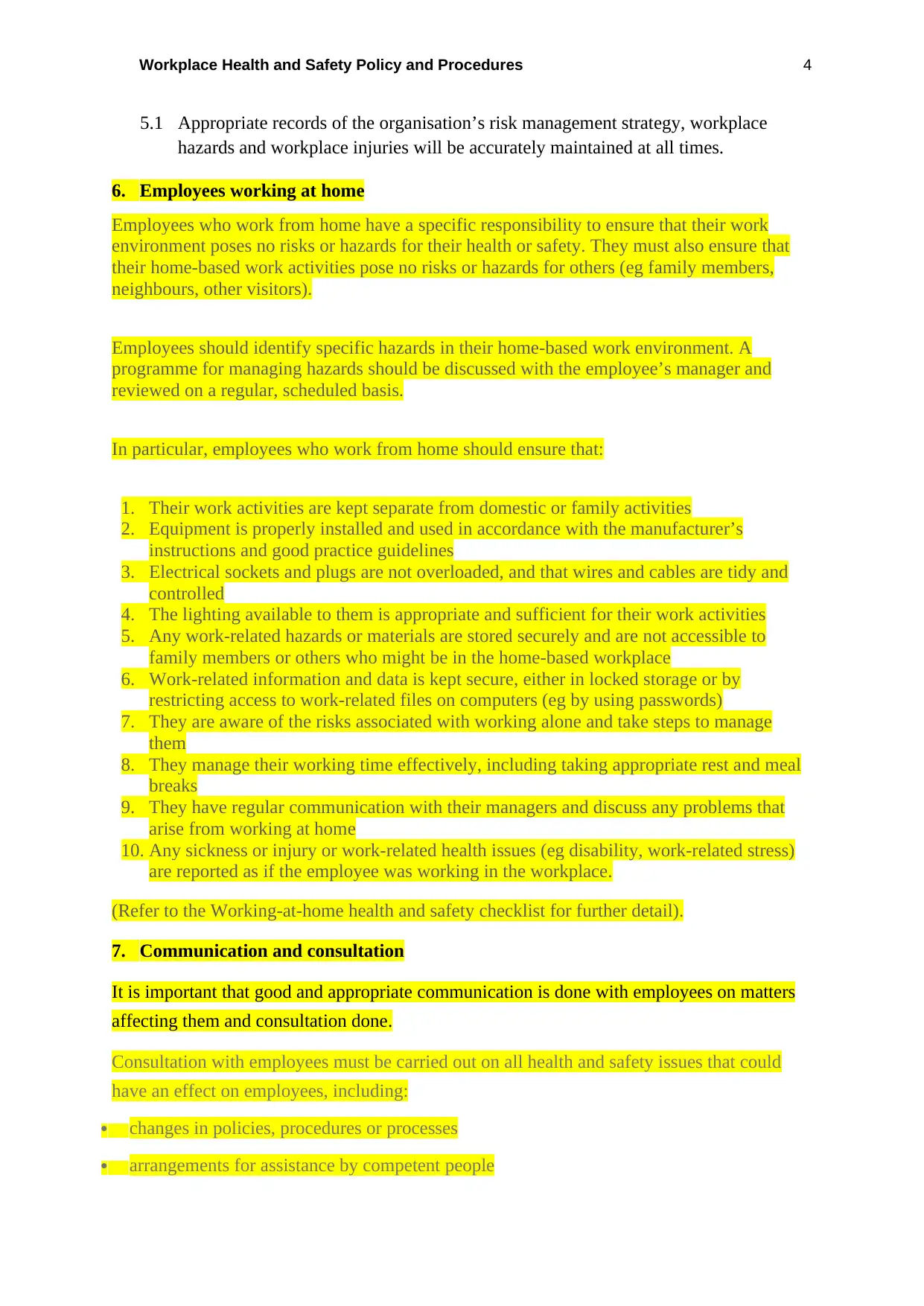
Workplace Health and Safety Policy and Procedures 4
5.1 Appropriate records of the organisation’s risk management strategy, workplace
hazards and workplace injuries will be accurately maintained at all times.
6. Employees working at home
Employees who work from home have a specific responsibility to ensure that their work
environment poses no risks or hazards for their health or safety. They must also ensure that
their home-based work activities pose no risks or hazards for others (eg family members,
neighbours, other visitors).
Employees should identify specific hazards in their home-based work environment. A
programme for managing hazards should be discussed with the employee’s manager and
reviewed on a regular, scheduled basis.
In particular, employees who work from home should ensure that:
1. Their work activities are kept separate from domestic or family activities
2. Equipment is properly installed and used in accordance with the manufacturer’s
instructions and good practice guidelines
3. Electrical sockets and plugs are not overloaded, and that wires and cables are tidy and
controlled
4. The lighting available to them is appropriate and sufficient for their work activities
5. Any work-related hazards or materials are stored securely and are not accessible to
family members or others who might be in the home-based workplace
6. Work-related information and data is kept secure, either in locked storage or by
restricting access to work-related files on computers (eg by using passwords)
7. They are aware of the risks associated with working alone and take steps to manage
them
8. They manage their working time effectively, including taking appropriate rest and meal
breaks
9. They have regular communication with their managers and discuss any problems that
arise from working at home
10. Any sickness or injury or work-related health issues (eg disability, work-related stress)
are reported as if the employee was working in the workplace.
(Refer to the Working-at-home health and safety checklist for further detail).
7. Communication and consultation
It is important that good and appropriate communication is done with employees on matters
affecting them and consultation done.
Consultation with employees must be carried out on all health and safety issues that could
have an effect on employees, including:
changes in policies, procedures or processes
arrangements for assistance by competent people
5.1 Appropriate records of the organisation’s risk management strategy, workplace
hazards and workplace injuries will be accurately maintained at all times.
6. Employees working at home
Employees who work from home have a specific responsibility to ensure that their work
environment poses no risks or hazards for their health or safety. They must also ensure that
their home-based work activities pose no risks or hazards for others (eg family members,
neighbours, other visitors).
Employees should identify specific hazards in their home-based work environment. A
programme for managing hazards should be discussed with the employee’s manager and
reviewed on a regular, scheduled basis.
In particular, employees who work from home should ensure that:
1. Their work activities are kept separate from domestic or family activities
2. Equipment is properly installed and used in accordance with the manufacturer’s
instructions and good practice guidelines
3. Electrical sockets and plugs are not overloaded, and that wires and cables are tidy and
controlled
4. The lighting available to them is appropriate and sufficient for their work activities
5. Any work-related hazards or materials are stored securely and are not accessible to
family members or others who might be in the home-based workplace
6. Work-related information and data is kept secure, either in locked storage or by
restricting access to work-related files on computers (eg by using passwords)
7. They are aware of the risks associated with working alone and take steps to manage
them
8. They manage their working time effectively, including taking appropriate rest and meal
breaks
9. They have regular communication with their managers and discuss any problems that
arise from working at home
10. Any sickness or injury or work-related health issues (eg disability, work-related stress)
are reported as if the employee was working in the workplace.
(Refer to the Working-at-home health and safety checklist for further detail).
7. Communication and consultation
It is important that good and appropriate communication is done with employees on matters
affecting them and consultation done.
Consultation with employees must be carried out on all health and safety issues that could
have an effect on employees, including:
changes in policies, procedures or processes
arrangements for assistance by competent people
Paraphrase This Document
Need a fresh take? Get an instant paraphrase of this document with our AI Paraphraser
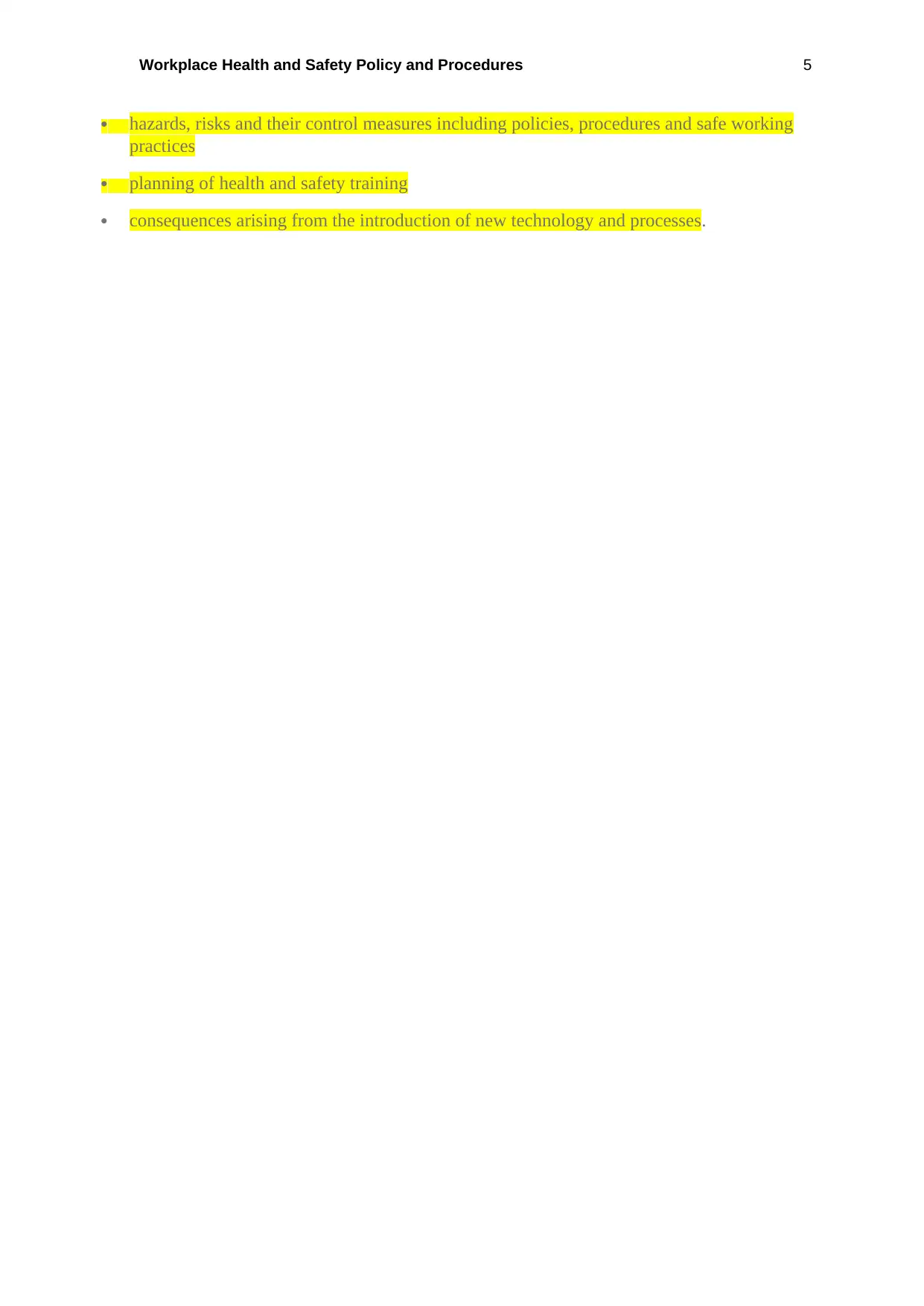
Workplace Health and Safety Policy and Procedures 5
hazards, risks and their control measures including policies, procedures and safe working
practices
planning of health and safety training
consequences arising from the introduction of new technology and processes.
hazards, risks and their control measures including policies, procedures and safe working
practices
planning of health and safety training
consequences arising from the introduction of new technology and processes.
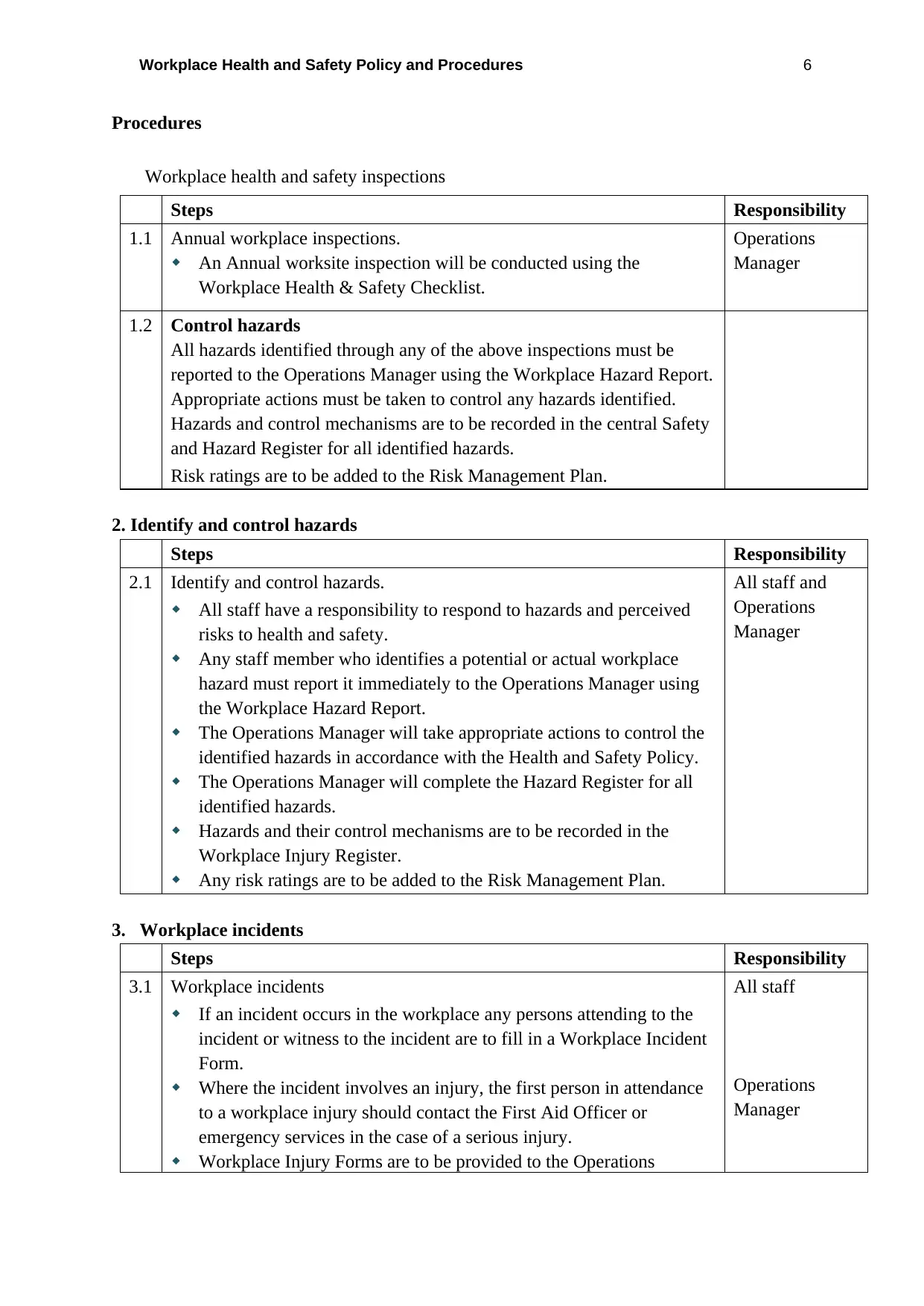
Workplace Health and Safety Policy and Procedures 6
Procedures
Workplace health and safety inspections
Steps Responsibility
1.1 Annual workplace inspections.
An Annual worksite inspection will be conducted using the
Workplace Health & Safety Checklist.
Operations
Manager
1.2 Control hazards
All hazards identified through any of the above inspections must be
reported to the Operations Manager using the Workplace Hazard Report.
Appropriate actions must be taken to control any hazards identified.
Hazards and control mechanisms are to be recorded in the central Safety
and Hazard Register for all identified hazards.
Risk ratings are to be added to the Risk Management Plan.
2. Identify and control hazards
Steps Responsibility
2.1 Identify and control hazards.
All staff have a responsibility to respond to hazards and perceived
risks to health and safety.
Any staff member who identifies a potential or actual workplace
hazard must report it immediately to the Operations Manager using
the Workplace Hazard Report.
The Operations Manager will take appropriate actions to control the
identified hazards in accordance with the Health and Safety Policy.
The Operations Manager will complete the Hazard Register for all
identified hazards.
Hazards and their control mechanisms are to be recorded in the
Workplace Injury Register.
Any risk ratings are to be added to the Risk Management Plan.
All staff and
Operations
Manager
3. Workplace incidents
Steps Responsibility
3.1 Workplace incidents
If an incident occurs in the workplace any persons attending to the
incident or witness to the incident are to fill in a Workplace Incident
Form.
Where the incident involves an injury, the first person in attendance
to a workplace injury should contact the First Aid Officer or
emergency services in the case of a serious injury.
Workplace Injury Forms are to be provided to the Operations
All staff
Operations
Manager
Procedures
Workplace health and safety inspections
Steps Responsibility
1.1 Annual workplace inspections.
An Annual worksite inspection will be conducted using the
Workplace Health & Safety Checklist.
Operations
Manager
1.2 Control hazards
All hazards identified through any of the above inspections must be
reported to the Operations Manager using the Workplace Hazard Report.
Appropriate actions must be taken to control any hazards identified.
Hazards and control mechanisms are to be recorded in the central Safety
and Hazard Register for all identified hazards.
Risk ratings are to be added to the Risk Management Plan.
2. Identify and control hazards
Steps Responsibility
2.1 Identify and control hazards.
All staff have a responsibility to respond to hazards and perceived
risks to health and safety.
Any staff member who identifies a potential or actual workplace
hazard must report it immediately to the Operations Manager using
the Workplace Hazard Report.
The Operations Manager will take appropriate actions to control the
identified hazards in accordance with the Health and Safety Policy.
The Operations Manager will complete the Hazard Register for all
identified hazards.
Hazards and their control mechanisms are to be recorded in the
Workplace Injury Register.
Any risk ratings are to be added to the Risk Management Plan.
All staff and
Operations
Manager
3. Workplace incidents
Steps Responsibility
3.1 Workplace incidents
If an incident occurs in the workplace any persons attending to the
incident or witness to the incident are to fill in a Workplace Incident
Form.
Where the incident involves an injury, the first person in attendance
to a workplace injury should contact the First Aid Officer or
emergency services in the case of a serious injury.
Workplace Injury Forms are to be provided to the Operations
All staff
Operations
Manager
⊘ This is a preview!⊘
Do you want full access?
Subscribe today to unlock all pages.

Trusted by 1+ million students worldwide
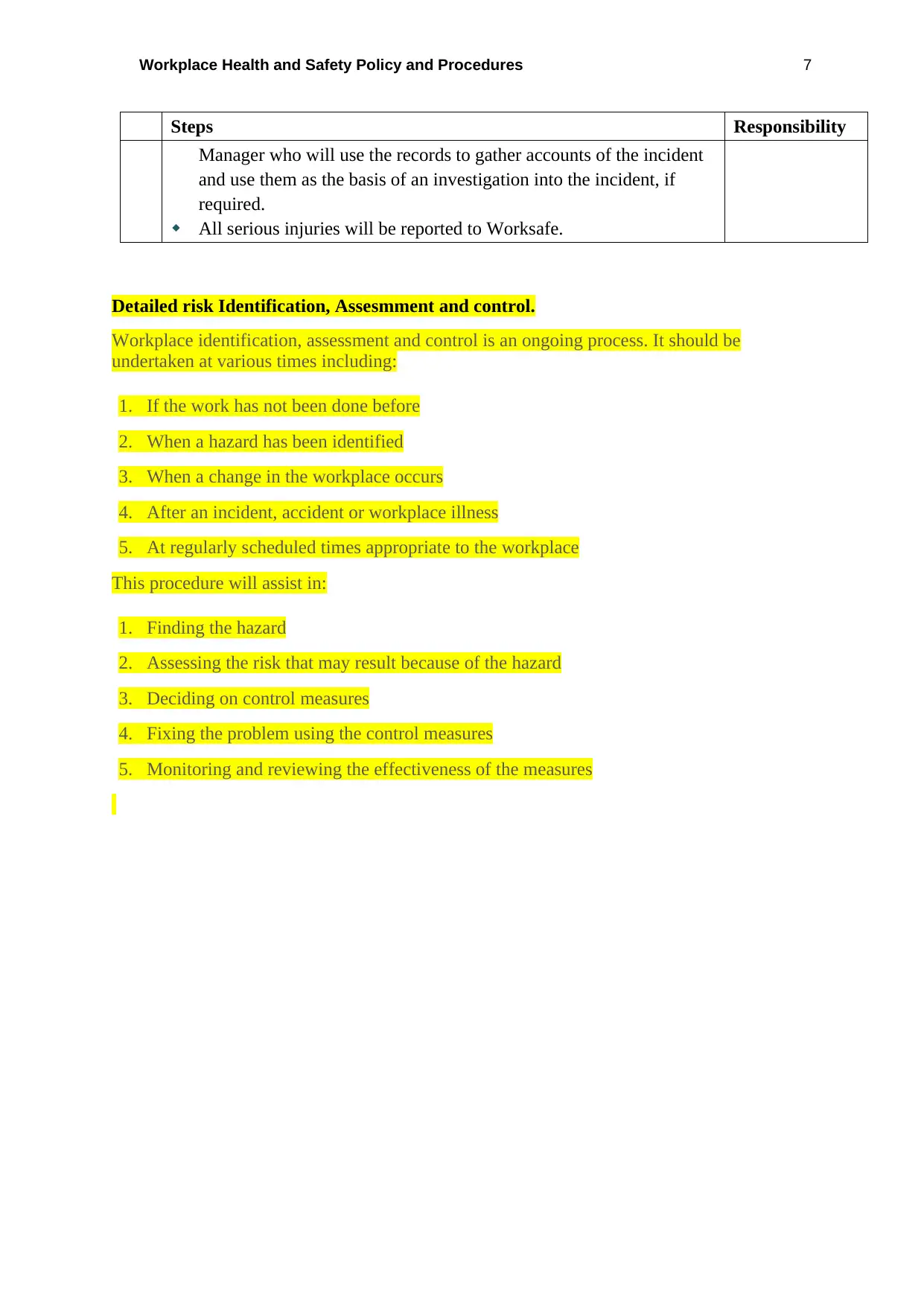
Workplace Health and Safety Policy and Procedures 7
Steps Responsibility
Manager who will use the records to gather accounts of the incident
and use them as the basis of an investigation into the incident, if
required.
All serious injuries will be reported to Worksafe.
Detailed risk Identification, Assesmment and control.
Workplace identification, assessment and control is an ongoing process. It should be
undertaken at various times including:
1. If the work has not been done before
2. When a hazard has been identified
3. When a change in the workplace occurs
4. After an incident, accident or workplace illness
5. At regularly scheduled times appropriate to the workplace
This procedure will assist in:
1. Finding the hazard
2. Assessing the risk that may result because of the hazard
3. Deciding on control measures
4. Fixing the problem using the control measures
5. Monitoring and reviewing the effectiveness of the measures
Steps Responsibility
Manager who will use the records to gather accounts of the incident
and use them as the basis of an investigation into the incident, if
required.
All serious injuries will be reported to Worksafe.
Detailed risk Identification, Assesmment and control.
Workplace identification, assessment and control is an ongoing process. It should be
undertaken at various times including:
1. If the work has not been done before
2. When a hazard has been identified
3. When a change in the workplace occurs
4. After an incident, accident or workplace illness
5. At regularly scheduled times appropriate to the workplace
This procedure will assist in:
1. Finding the hazard
2. Assessing the risk that may result because of the hazard
3. Deciding on control measures
4. Fixing the problem using the control measures
5. Monitoring and reviewing the effectiveness of the measures
Paraphrase This Document
Need a fresh take? Get an instant paraphrase of this document with our AI Paraphraser
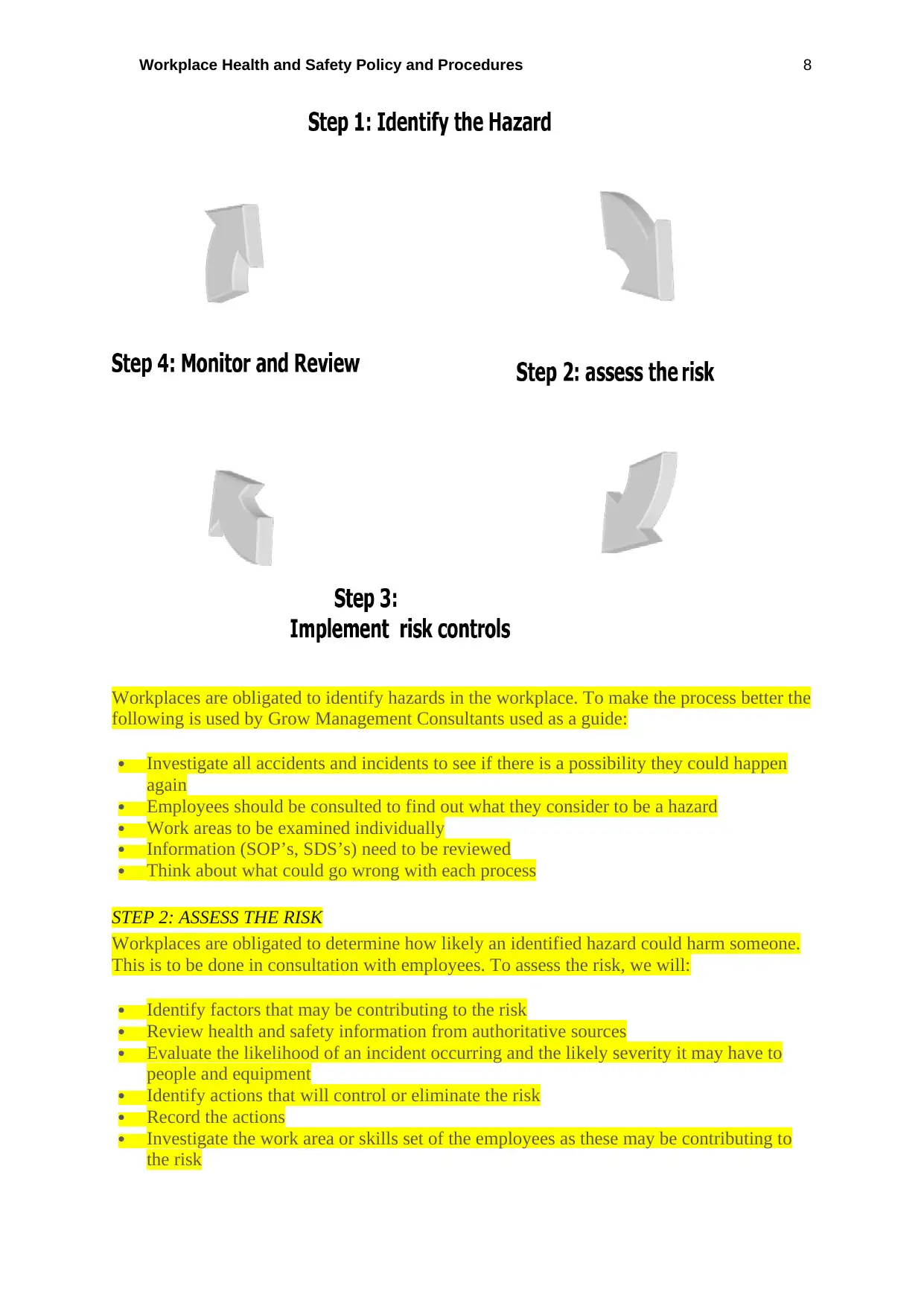
Workplace Health and Safety Policy and Procedures 8
Workplaces are obligated to identify hazards in the workplace. To make the process better the
following is used by Grow Management Consultants used as a guide:
Investigate all accidents and incidents to see if there is a possibility they could happen
again
Employees should be consulted to find out what they consider to be a hazard
Work areas to be examined individually
Information (SOP’s, SDS’s) need to be reviewed
Think about what could go wrong with each process
STEP 2: ASSESS THE RISK
Workplaces are obligated to determine how likely an identified hazard could harm someone.
This is to be done in consultation with employees. To assess the risk, we will:
Identify factors that may be contributing to the risk
Review health and safety information from authoritative sources
Evaluate the likelihood of an incident occurring and the likely severity it may have to
people and equipment
Identify actions that will control or eliminate the risk
Record the actions
Investigate the work area or skills set of the employees as these may be contributing to
the risk
Workplaces are obligated to identify hazards in the workplace. To make the process better the
following is used by Grow Management Consultants used as a guide:
Investigate all accidents and incidents to see if there is a possibility they could happen
again
Employees should be consulted to find out what they consider to be a hazard
Work areas to be examined individually
Information (SOP’s, SDS’s) need to be reviewed
Think about what could go wrong with each process
STEP 2: ASSESS THE RISK
Workplaces are obligated to determine how likely an identified hazard could harm someone.
This is to be done in consultation with employees. To assess the risk, we will:
Identify factors that may be contributing to the risk
Review health and safety information from authoritative sources
Evaluate the likelihood of an incident occurring and the likely severity it may have to
people and equipment
Identify actions that will control or eliminate the risk
Record the actions
Investigate the work area or skills set of the employees as these may be contributing to
the risk
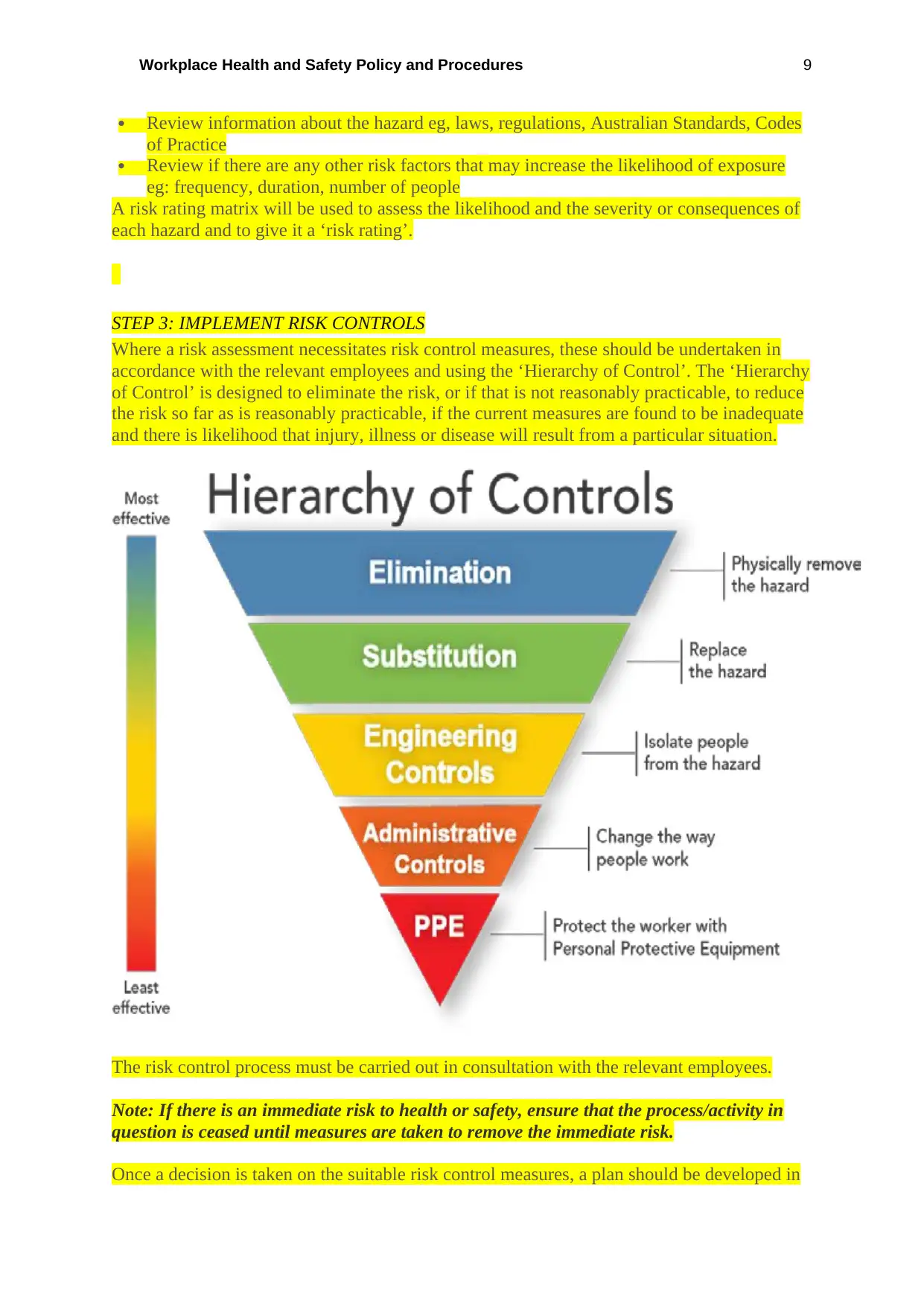
Workplace Health and Safety Policy and Procedures 9
Review information about the hazard eg, laws, regulations, Australian Standards, Codes
of Practice
Review if there are any other risk factors that may increase the likelihood of exposure
eg: frequency, duration, number of people
A risk rating matrix will be used to assess the likelihood and the severity or consequences of
each hazard and to give it a ‘risk rating’.
STEP 3: IMPLEMENT RISK CONTROLS
Where a risk assessment necessitates risk control measures, these should be undertaken in
accordance with the relevant employees and using the ‘Hierarchy of Control’. The ‘Hierarchy
of Control’ is designed to eliminate the risk, or if that is not reasonably practicable, to reduce
the risk so far as is reasonably practicable, if the current measures are found to be inadequate
and there is likelihood that injury, illness or disease will result from a particular situation.
The risk control process must be carried out in consultation with the relevant employees.
Note: If there is an immediate risk to health or safety, ensure that the process/activity in
question is ceased until measures are taken to remove the immediate risk.
Once a decision is taken on the suitable risk control measures, a plan should be developed in
Review information about the hazard eg, laws, regulations, Australian Standards, Codes
of Practice
Review if there are any other risk factors that may increase the likelihood of exposure
eg: frequency, duration, number of people
A risk rating matrix will be used to assess the likelihood and the severity or consequences of
each hazard and to give it a ‘risk rating’.
STEP 3: IMPLEMENT RISK CONTROLS
Where a risk assessment necessitates risk control measures, these should be undertaken in
accordance with the relevant employees and using the ‘Hierarchy of Control’. The ‘Hierarchy
of Control’ is designed to eliminate the risk, or if that is not reasonably practicable, to reduce
the risk so far as is reasonably practicable, if the current measures are found to be inadequate
and there is likelihood that injury, illness or disease will result from a particular situation.
The risk control process must be carried out in consultation with the relevant employees.
Note: If there is an immediate risk to health or safety, ensure that the process/activity in
question is ceased until measures are taken to remove the immediate risk.
Once a decision is taken on the suitable risk control measures, a plan should be developed in
⊘ This is a preview!⊘
Do you want full access?
Subscribe today to unlock all pages.

Trusted by 1+ million students worldwide
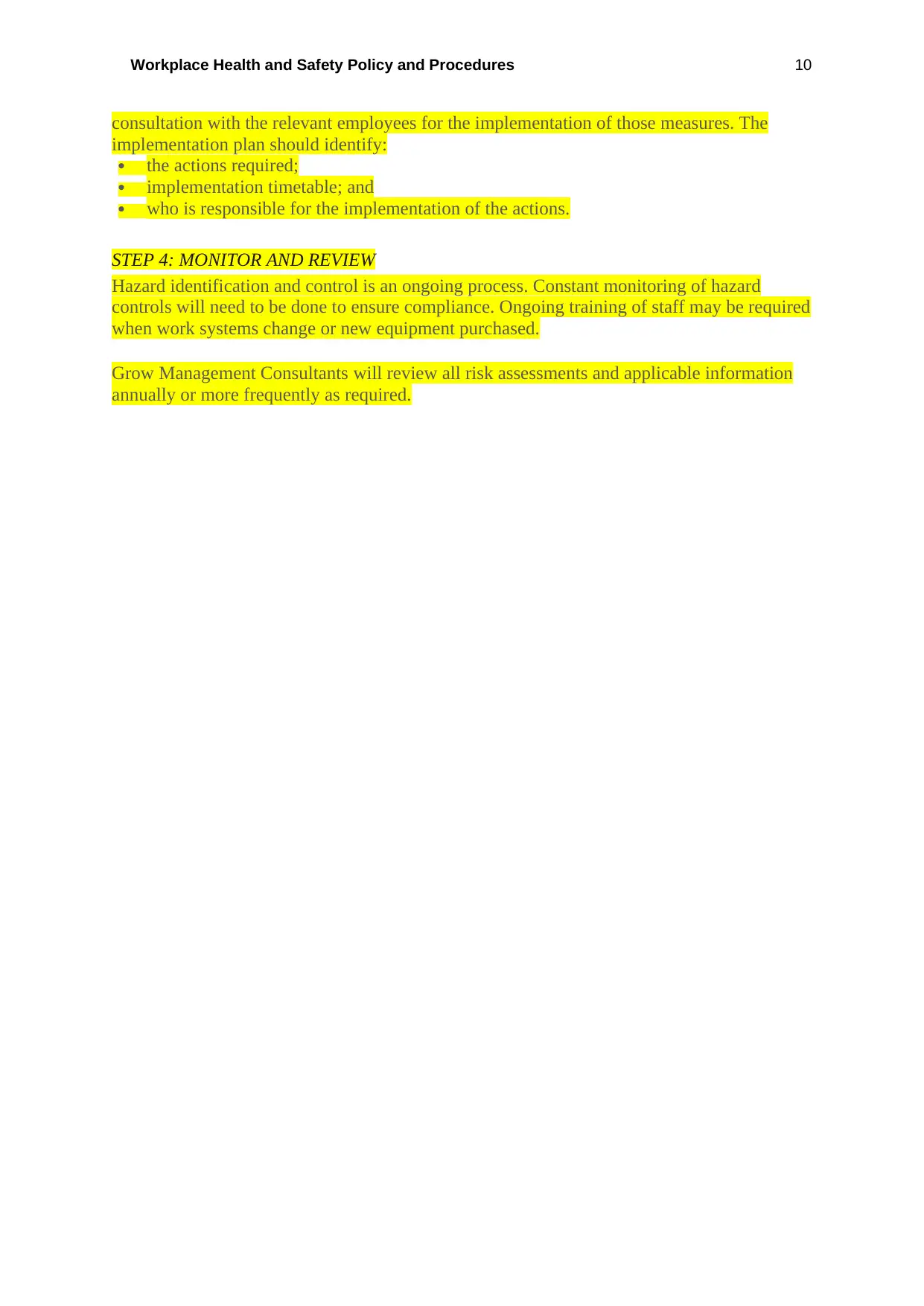
Workplace Health and Safety Policy and Procedures 10
consultation with the relevant employees for the implementation of those measures. The
implementation plan should identify:
the actions required;
implementation timetable; and
who is responsible for the implementation of the actions.
STEP 4: MONITOR AND REVIEW
Hazard identification and control is an ongoing process. Constant monitoring of hazard
controls will need to be done to ensure compliance. Ongoing training of staff may be required
when work systems change or new equipment purchased.
Grow Management Consultants will review all risk assessments and applicable information
annually or more frequently as required.
consultation with the relevant employees for the implementation of those measures. The
implementation plan should identify:
the actions required;
implementation timetable; and
who is responsible for the implementation of the actions.
STEP 4: MONITOR AND REVIEW
Hazard identification and control is an ongoing process. Constant monitoring of hazard
controls will need to be done to ensure compliance. Ongoing training of staff may be required
when work systems change or new equipment purchased.
Grow Management Consultants will review all risk assessments and applicable information
annually or more frequently as required.
1 out of 10
Related Documents
Your All-in-One AI-Powered Toolkit for Academic Success.
+13062052269
info@desklib.com
Available 24*7 on WhatsApp / Email
![[object Object]](/_next/static/media/star-bottom.7253800d.svg)
Unlock your academic potential
Copyright © 2020–2025 A2Z Services. All Rights Reserved. Developed and managed by ZUCOL.




